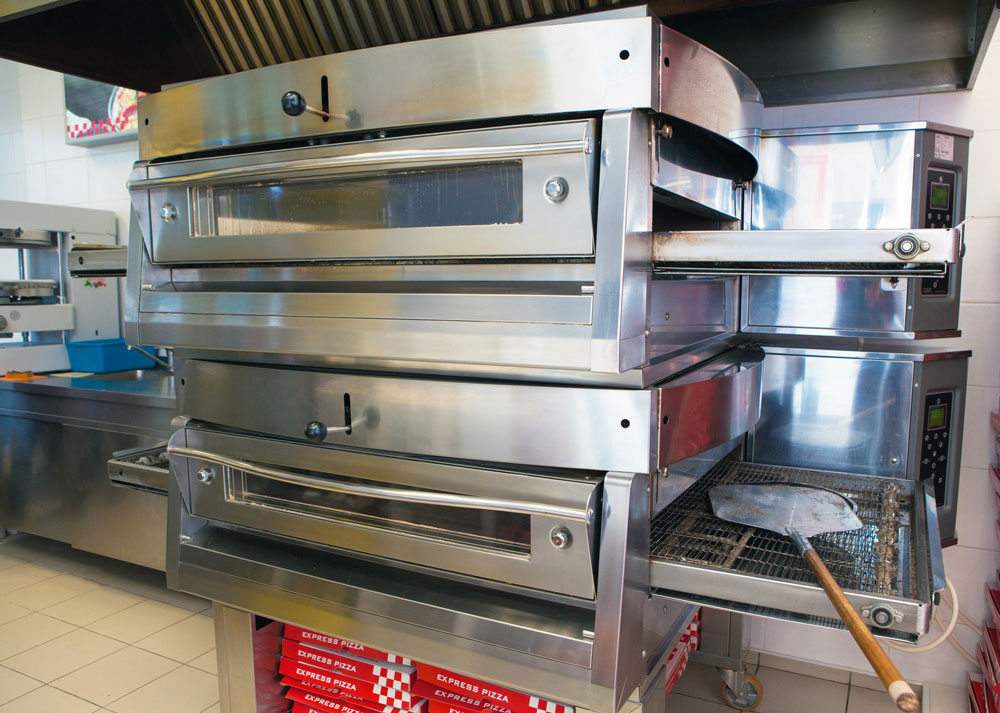- Daniel Estrada, CEO and co-founder of 86 Repairs, says his pizzeria clients are three times more likely to use a conveyor oven than a deck oven.
- The average repair cost for a conveyor oven is $775, while the average repair cost for a deck oven is $552, Estrada says.
Related: The pros and cons of gas and electric pizza ovens
By Tracy Morin
Choosing the right oven is one of the biggest decisions a pizzeria owner will make. And there’s no one right answer—it’s a highly personal decision determined by everything from the desired pizza style to the area’s potential labor pool. “It’s important to consider your restaurant’s concept, volume, staffing and business needs to determine which oven will produce the best results for your establishment and maximize profits,” advises Daniel Estrada, CEO and co-founder of Chicago-based 86 Repairs. “But, generally, we see two primary types of ovens among our customers’ assets: conveyor ovens and deck ovens. ” Here, Estrada breaks down the operation—and evaluates the possible breakdowns—of these two common types.
PMQ: How do you choose the right oven for a pizzeria operation?

Estrada: Conveyor ovens are great for fast-casual restaurants, including takeout, delivery and chains, since they’re consistent and ideal for high volumes. Using convection heat, conveyor ovens can produce about 80 pizzas per hour. While they take up more physical space than a deck oven, they offer a shorter cooking time and require less operating skill than a deck oven. Conveyor ovens can make great New York-style pizzas with light or medium amounts of toppings and thinner crusts.
Deck ovens are well-suited for Chicago- and Sicilian-style pizzas and can handle more toppings and thicker crusts. Deck ovens are more commonly found in full-service restaurants and gourmet pizzerias with longer menus and various topping options.
A conveyor oven has consistent temperature within the oven and is set to cook for a certain amount of time. Deck ovens are hotter in the back than the front—so the pizza maker has to manage where the pizza sits and the cooking time.
Our pizzeria customers are 3.1 times more likely to have a conveyor oven in their kitchen than a deck oven. QSR operations, such as Little Caesars and Papa John’s, are double- or even triple-stacking their conveyor ovens to maximize efficiency and physical space, and to fulfill high-volume orders.
Related: Why conveyor ovens remain a popular choice for pizzerias
PMQ: What are the most common repair issues for these oven types?
Estrada: The most common issue we see with a conveyor oven is no power, which accounts for 19.77% of service requests on the asset. The most common issue we see with a deck oven is not holding temperature, which accounts for 28.57% of service requests.
“On average, it costs 40% more to repair a conveyor oven. The average repair cost for a conveyor oven is $775, while the average repair cost for a deck oven is $552.”
— Daniel Estrada, 86 Repairs
PMQ: When needed, what are the frequency and average costs for these repairs?
Estrada: On average, it costs 40% more to repair a conveyor oven. The average repair cost for a conveyor oven is $775, while the average repair cost for a deck oven is $552. Additionally, parts and service for deck ovens historically cost less than conveyor ovens, because conveyor ovens have many costly parts and more intricate repairs. However, the average mean time to resolution (MTTR) for a deck oven is three times longer than the average MTTR for conveyor oven incidents.

PMQ: Do you have any maintenance tips to help prevent needing more repairs?
Estrada: Regular cleaning is the best preventative measure an operator can take for his pizza ovens. Conveyor ovens are designed to be as self-maintained as possible, but operators can extend the lifespan of their equipment and reduce operating costs by keeping them clean. Meanwhile, deck pizza ovens may use stone or stainless steel to help crisp the pizza crust, so they require some special cleaning. Take the following steps for each type.
For conveyor ovens:
Daily Cleaning
- Remove and wipe down trays, baffles and other removable parts and guards with a soft cloth and noncaustic cleanser. Rinse with warm water and air dry.
- Clean the conveyor belt with a wire brush.
- Clear the inside of the oven of all crumbs, clean with a mild detergent, and rinse all areas with warm water afterward.
- Check to make sure all air intake vents remain clear, clean and free of all debris.
Weekly Cleaning
- Remove and wipe down trays, baffles and other removable parts and guards with a soft cloth and noncaustic cleanser. Rinse with warm water and air dry.
- Remove the conveyor belt and impinger fingers. Using a soft cloth, wipe down the revealed surface areas.
- Apply cleanser to the belt/fingers and let it sit for about 20 minutes. Then brush them down with a soft-bristle brush.
“We recommend the ‘dollar bill’ test on all ovens to make sure they have a good seal. Try to slide a dollar bill between the gasket and the door—if it slides through, replace the gasket. ”
— Daniel Estrada, 86 Repairs
For deck ovens:
- Burn off food remnants by turning on the oven and raising the heat; do not use water and cleanser.
- Wipe down the interior chamber with a soft cloth with warm water and a mild dish detergent. (Oven cleaner or caustic materials can damage the interior.)
- Scrape or brush the deck(s) to remove stuck-on remnants. You can find special long-handle scraping tools or stiff wired brushes to remove burned food. Do not remove the food particles by hand.
- Depending on the oven setup, ventilation inspection can be essential. One surprising item to check is specifically for spring-loaded doors. These springs often fail over time and cause the door to drop hard or not stay closed, causing safety and performance issues.
- Checking gaskets prevents hot air from escaping and uneven baking. We recommend the “dollar bill” test on all ovens to make sure they have a good seal. Do this by trying to slide a dollar bill between the gasket and the door—if it slides through, replace the gasket.
- A solid, well-executed preventative maintenance plan can yield up to 20% lower operating costs over the life of a long-term asset like these ovens. And an oven being down one night might mean missing weekend sales by 50% or more.
Related: Fire in the hole! Warming up to wood-fired ovens

PMQ: Has COVID-19 impacted the availability of oven parts or slowed down the repair process at all?
Estrada: We are still seeing the effects of parts shortages across every industry segment and every market we operate in. Parts that used to take days now take weeks, because suppliers can’t provide materials to manufacturers, and manufacturers can’t provide equipment to customers.
The lack of labor exacerbates this supply shortage. Not only are there fewer factory workers creating parts, but there’s also a big issue with distribution. Without enough drivers, logistics are a nightmare.
As with any larger piece of equipment, there are many structural components of pizza ovens and, therefore, many things that can go wrong. And, to avoid voiding the warranty, parts must be replaced by manufacturer-authorized vendors with the correct part for the unit, which can extend wait times and force customers to refuse alternate readily available vendors or parts. This can be especially challenging when a full-service operation has only one pizza oven to work with.
PMQ: Do you have any final thoughts on ovens that pizzeria owners might find useful?
Estrada: Conveyor ovens have more parts, which is why they are generally more expensive to fix. On the other hand, deck ovens require someone experienced to monitor and operate them in order to achieve consistent quality, whereas conveyor ovens require less skill and less monitoring. Choose your oven wisely!
Tracy Morin is PMQ’s senior copy editor and the editor of PizzaVegan.com.















